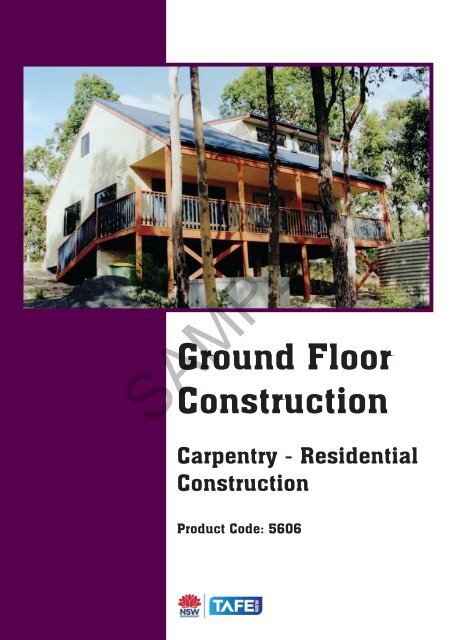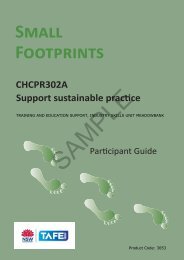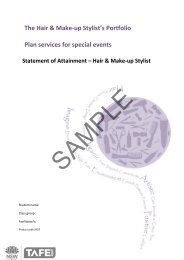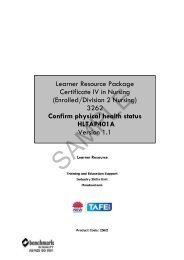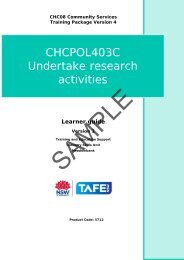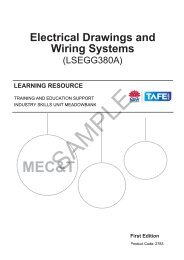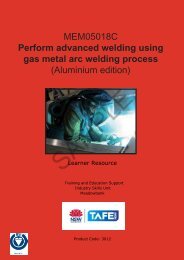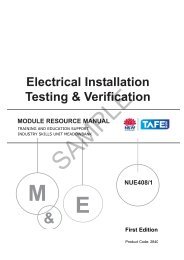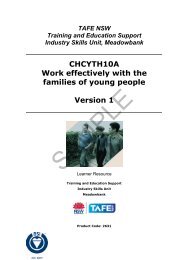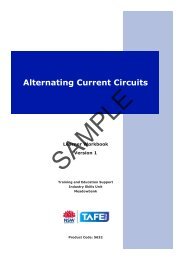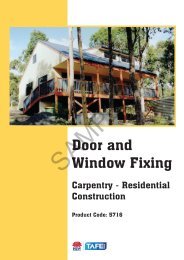Create successful ePaper yourself
Turn your PDF publications into a flip-book with our unique Google optimized e-Paper software.
<strong>Ground</strong> <strong>Floor</strong><strong>Construction</strong>SAMPLECarpentry - Residential<strong>Construction</strong>Product Code: 5606
GROUND FLOOR CONSTRUCTIONPublishing details:Second Edition 2012TAFE NSW Training and Education Support, Industry Skills Unit Orange and Granville68 South StreetGranville NSW 2142Telephone: (02)9846 8101© NSW TAFE Commission/DECAcknowledgementsContributors:1 st Edition – CARP06/03David MoranMike LeahyBrian MoranPaslode Australia and Dom SamperiRob Young2 nd EditionNorman Hunter – for revisionMasterbuilt Homes Pty Ltd for use of Cover PhotoSue Linsen, Can Do Management for desktop publishingPartner Housing AustraliaSouth Western Sydney Institute – Chullora CampusDisclaimer- CopyrightEvery effort has been made to trace and acknowledge copyright. However, should any infringement haveoccurred, TAFE NSW Training and Education Support, Industry Skills Unit Orange and Granville extendsan apology and invites copyright owners to contact them. Throughout this book, registered trademarks areindicated by an initial capital letter.ISBN 0 9 780 734 815 545SAMPLE©TAFE NSW Training and Education Support, Industry Skills Unit Orange and Granville, 2012Copyright of this material is reserved to TAFE NSW Training and Education Support, Industry Skills UnitOrange and Granville. Reproduction or transmittal in whole or part, other than for the purposes andsubject to the provision of the Copyright Act, is prohibited without the written authority of TAFE NSWTraining and Education Support, Industry Skills Unit Orange and Granville.2© TAFE NSW Training and Education Support, Industry Skills Unit Orange and Granville
GROUND FLOOR CONSTRUCTIONContentsGROUND FLOOR CONSTRUCTION OVERVIEW 4GROUND FLOOR SUPPORTING SYSTEMS FOR FLOOR FRAMes 4ACCESS FOR SUB-FLOOR INSPECTION 12TERMITE SHIELDs 13SUSPENDED TIMBER FLOOR SYSTEM 15THE FLOORING 25Suspended Reinforced Concrete 42Suspended Deep Joist I-Beam <strong>Floor</strong> Frames 43Special Joist and Beam Systems 44CALCULATION OF SUB-FLOOR MEMBERs 46BEARER AND JOIST QUANTITIes 50SAMPLEFLOORING QUANTITIes 52FURTHER READING57Strip <strong>Floor</strong>inG 52GLOSSARY OF TERMs 56© TAFE NSW Training and Education Support, Industry Skills Unit Orange and Granville 3
GROUND FLOOR CONSTRUCTIONGROUND FLOOR CONSTRUCTION OVERVIEWThis text introduces a variety of subject matter related to Building and <strong>Construction</strong>, at atrade level.It outlines both traditional and alternate suspended timber flooring systems as well asupper floor construction methods for two storey work.Calculation procedures relating to traditional floor frame member quantities, tongue andgroove (strip) and sheet flooring and costs are clarified and examples provided.<strong>Ground</strong> floor construction in domestic buildings can be broken up into three broad areas:• <strong>Ground</strong> floor supporting systems for floor frames• The flooring frame itself• The flooringGROUND FLOOR SUPPORTING SYSTEMS FOR FLOOR FRAMESThe isolated support system includes all isolated masonry piers (brick, block or stone),timber (stumps, posts or poles) and steel columns.MasonryThis system consists of isolated brick, block or stone piers. Brick piers are generally230mm square supported on concrete pad footings. This type of pier is seldom braced,as the accepted maximum height for a 230mm square pier is only 6 times the least basemeasurement, i.e. for a 230mm square pier = 1380mm.Piers, which are increased in height, must be increased in overall base dimensionsto compensate for the lack of stability and should not exceed 3.0m in height, withoutcertification from a Structural Engineer.SAMPLEThe tops of all piers should be level and in-line to prevent unnecessary packing of bearers230mm pier1380 mm max200mm minimum provideda clearance of 400mmis maintained 2000mmmaximum out from pier200mm thick concrete pad or blob footing4© TAFE NSW Training and Education Support, Industry Skills Unit Orange and Granville
GROUND FLOOR CONSTRUCTIONTimberTraditionally, timber stumps are more commonly found in Victoriaand Queensland. They are felled from class 1 durable timber suchas Tallowwood, Turpentine and Ironbark. This style of sub-floorconstruction in still readily seen in Queensland today.Poles or posts are normally round and made of durable Class 1 timbers or must bechemically treated to improve their durability. They should also comply with AS1684.2 –Timber Framing Code for minimum diameter and maximum height above ground level.SAMPLENails or spikes may berequiredM12 cranked bolt through bearerwith M12 bolt through stump© TAFE NSW Training and Education Support, Industry Skills Unit Orange and Granville 5
GROUND FLOOR CONSTRUCTIONSteelSteel posts can be connected tothe footing by the use of a steelbottom plate embedded intothe concrete. Alternatively theymay be bolted using masonryanchors. This product is normallygalvanised to ensure itslongevity and its choice may bean option for high termite proneareas.An alternative adjustable pier system is knownby its trade name of “Uni-Pier” It consists of ahollow square steel tube which has an adjustabletelescopic shaft with a base plate at one end anda base plate at one end and a fixing bracket at theother, complete with it’s own built-in ant cap. Ithas a hot-dipped galvanised steel shaft with anadjustable top section, which is bolted throughfor load bearing applications. The base plate iswelded to the shaft and may be masonry bolted to aconcrete pad or be cast into the concrete pad to actas an anchor. The top or head section has a bearerfixing bracket welded to the bearer plate/ant cap,which in turn is welded to the head section. Thehead section has a self-drilling screw to allow fixingoff to a level, straight height before the load-bearingbolt is drilled through and fixed.SAMPLE6© TAFE NSW Training and Education Support, Industry Skills Unit Orange and Granville
GROUND FLOOR CONSTRUCTIONFibre reinforced concreteAs an alternative to conventional footing systems, advances in technology have seenthe introduction of an ultra-lightweight proprietary blend, with fibre reinforcing addingstrength and durability that is three times lighter than standard concrete.This offers a foundation system in areas where ground movement is an issue, whereshrinkage and expansion is common. In addition, this system allows a good alternativewhere bedrock or hard earth prevents ease of excavation for an in-ground concrete base.Tie down installationTypical InstallationUse Handi Blocks in conjunction with traditionalconcrete and steel support methods.Posts are only required on unlevelled ground orwhere an elevated platform is required. Typicallyjoists can be installed directly on Handi Blocks forlow level structures.Handi Blocks are designed to accept standard nominal timber. The most common timberdimensions used are 90mm X 90mm treated pine posts and 35mm X 140/190mm treatedpine joists or bearers. Because the Handi Blocks are a composite material, modificationcan be carried out using a normal timber handsaw.SAMPLE90mm x 90mm post 35mm x 140/190mm Bearers Modifying block to accept45mm wide timber© TAFE NSW Training and Education Support, Industry Skills Unit Orange and Granville 7
GROUND FLOOR CONSTRUCTIONContinuous Support SystemsCommon Support System for Residential StructuresFoundation or ‘Dwarf’ walls for timber frame, brick veneer and cavity brick constructionare usually 110 mm thick and are strengthened by engaged or attached piers, 230 mmx 110 mm, bonded or tied to them at designated centres to suit the size and stress gradeof bearers. Generally the internal area of the floor frame is supported on 230 x 230mmisolated brick piers.Attached or engaged pier(230 x 110)Timber Framed Structures110mm Dwarf wall‘Briktor’used totie pierto wallIsolated sleeper orIsland pier (230 x 230)Attached pierThis system may be constructed of external dwarf walls, engaged piers and isolated 230x 230mm mid floor supports or simply have 230 x 230mm isolated piers around theperimeter and supporting the mid floor area.Brick Veneer StructuresSAMPLEThis is the most common type of residential construction design with the external 110mmskin being built from the top of the footing to the underside of the eaves. The sub-floorarea consists of the 110mm external skin with brick piers being attached to it, usually bybuilding in brick ties or reinforcing wire (Bricktor), at centres to suit the size and stressgrade of the bearers. The tops of the piers are capped with termite shields (half caps) andthe external walls have continuous termite shields built-in for the full length betweenpiers. A damp-proof course (DPC) is usually placed directly under the termite shields.8© TAFE NSW Training and Education Support, Industry Skills Unit Orange and Granville


